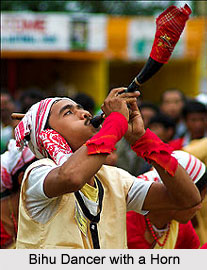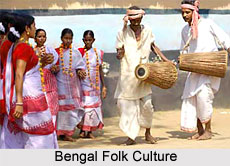 Folk music in East India has been largely inspired from folklore. The modern concept of `folklore` is marked to extend the idea of `folk` meaning, first, the uniformity in life and custom of groups living outside urban and city areas. Music of these folk-people was represented through songs and materials of the past, but is used as living form of art in the life of today. The old form of life is fast decaying, rural areas are being urbanized or industrialized and rural customs are merging in the new system of life. But even under this changing condition attempts to preserve traditional, old and medieval folk-music patterns can be traced.
Folk music in East India has been largely inspired from folklore. The modern concept of `folklore` is marked to extend the idea of `folk` meaning, first, the uniformity in life and custom of groups living outside urban and city areas. Music of these folk-people was represented through songs and materials of the past, but is used as living form of art in the life of today. The old form of life is fast decaying, rural areas are being urbanized or industrialized and rural customs are merging in the new system of life. But even under this changing condition attempts to preserve traditional, old and medieval folk-music patterns can be traced.
It was in a mixed-up circumstance that folklore as a tradition shaped in proverbs, folk-tales, ballads, festival songs, ceremonial songs, calendric songs, etc., at different times. Music of folk-song has been retained in the same way. Of the other types of songs, the most peculiar feature is present in the Bhatiali music of Bangladesh, which is primarily a solo secular song originated for characterizing emotional expression of a villager or boatman on the wide fields or on the river bosom respectively. Normally, a picture of a boatman up or down the river crops up in the mind, whatever may be the connection with the ideas of separation of man and woman represented in these texts.
 Solo music of seven notes developed peculiarly and influenced all other types of songs making it a full-fledged style. The background of these songs may be unearthed from the tunes of famous ballads of East Bengal, the secular narratives where pictures and songs of the life and the ideas of man-woman relations are depicted closely. Amongst secular songs bihugit, bongit in Assamese are rarest features which indicate basic ethnic characters but peculiarly developed along with the festival in the Indian state of Assam. Music of folk-songs has thus grown under different circumstances but it has been retained by people in memory as an oral tradition.
Solo music of seven notes developed peculiarly and influenced all other types of songs making it a full-fledged style. The background of these songs may be unearthed from the tunes of famous ballads of East Bengal, the secular narratives where pictures and songs of the life and the ideas of man-woman relations are depicted closely. Amongst secular songs bihugit, bongit in Assamese are rarest features which indicate basic ethnic characters but peculiarly developed along with the festival in the Indian state of Assam. Music of folk-songs has thus grown under different circumstances but it has been retained by people in memory as an oral tradition.
This also explains that music is always exposed to external influences, and thus a conglomeration of primitive and chaste or popular forms has gradually come in vogue. This reality proves the existence of folk-music as non-primitive art., Folk-music in Bengal in the nineteenth century was forced by upper classes to shape as doggerel verses (party-performance of Kavi, Tarja, Jatra, Half-akhdai, Pala, etc.). And spontaneous performance of music of the lower cultivating classes came up to the upper society through talented musicians. Now there are other factors. Oppressive upper society was also active at some instances in the past. Oppressed villagers then with their nostalgic agony took resort to their domestic songs inside their homes. It is interesting to note that some people of different ethnic groups, who settled in plains or near about the greater agricultural society, maintained their identity for some time, but later they were gradually integrated to agricultural people because they imbibed almost a common principle of livelihood. They contributed to the homogenous culture of general music to a certain extent, e.g. Santals in West Bengal borders, Bodo-Kachharis in Assam. This is how some primitive groups reached folk-cult or folk-song. On the whole, the thought and culture, based on many such traditions coexisting in the country, brought about almost a uniform outlook. To adjudge folk-music and tribal forms, therefore, general principles of popular Indian music are considered helpful.)
 Musical quality and voice range of the people of underdeveloped areas are more significant than what they are in tribal and primitive music. Rigidity of oral tradition in primitive forms, in spite of its spontaneity, is much relaxed in folk-music. And so a gradual improvement takes place in rendition of tune and rhythm of folk-music imperceptibly in course of time. Folk-music is an outcome of "less individualized" society, and is stable in form and structure. The frame of musical structure is set to form a common melody of traditional moods and expressions known to all. Stability and commonness of musical motives are established through persistent repetition. Melodic patterns and fragments of tunes are limited in number and are introduced through repetition. As a result of modern utilization and improved technique of performance, as songs are revitalized by ideology of socio-economic changes, the scope of folk-music has become controversial.
Musical quality and voice range of the people of underdeveloped areas are more significant than what they are in tribal and primitive music. Rigidity of oral tradition in primitive forms, in spite of its spontaneity, is much relaxed in folk-music. And so a gradual improvement takes place in rendition of tune and rhythm of folk-music imperceptibly in course of time. Folk-music is an outcome of "less individualized" society, and is stable in form and structure. The frame of musical structure is set to form a common melody of traditional moods and expressions known to all. Stability and commonness of musical motives are established through persistent repetition. Melodic patterns and fragments of tunes are limited in number and are introduced through repetition. As a result of modern utilization and improved technique of performance, as songs are revitalized by ideology of socio-economic changes, the scope of folk-music has become controversial.




















